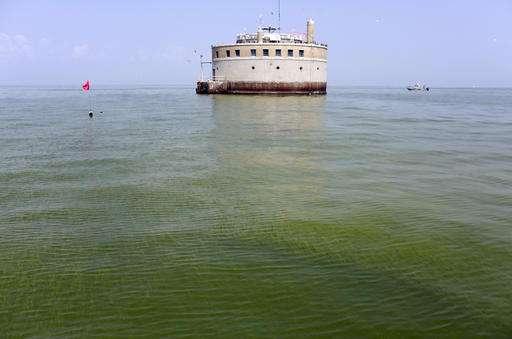Groups: Work curbing Lake Erie algae need to target hotspots

The algae bloom in parts of Lake Erie this summer didn't come close to matching the record-breaking one from a year ago that covered an area roughly the size of New York City.
That's because the spring and early summer months this year lacked the rainfall that has in recent years swept huge amounts phosphorus-filled farm fertilizer and livestock manure into the lake's tributaries, fueling the harmful algae outbreaks.
Despite what was a relatively mild bloom, there's still a long way to go before the problem is solved.
While environmental groups, farmers and state regulators don't always agree on what steps to take, they seem to have found some common ground—the efforts need to focus on hotspots where most of the phosphorus originates.
Just over 40 percent of the farmland in the western Lake Erie region accounts for nearly 80 percent of the phosphorus that flows into the lake through the Maumee River, said Jeff Reutter, a former director of the Sea Grant Program, who has studied the lake for decades.
Getting all farmers to follow voluntary efforts that encourage using the right amount of fertilizer at the right time and the right place would go a long way to improving water quality, he said.
But studies have shown that about one-third don't seem willing to make those changes without being offered incentives or faced with more regulations, he said.
There are two bills that have been introduced that would offer Ohio farmers tax incentives—one for investing in manure storage sites and another for installing grass strips that filter and reduce the phosphorus washing into streams and rivers.
Karl Gebhardt, who oversees water resources for the Ohio Environmental Protection Agency, said incentives need to be targeted to make sure they are making a difference.
Ohio officials are working to finalize a plan to make a 40 percent reduction in the amount of phosphorus that flows into the lake's western end.
Changes put in place by the state's legislature, including a ban on spreading manure and fertilizer on frozen and soggy fields, are too new to determine how much they will help.
Environmental groups doubt those steps and the voluntary efforts to encourage farmers to use less fertilizer will be enough to stop the lake from turning unsightly shades of green from the algae.
Adam Rissien, the Ohio Environmental Council's director of agricultural and water policy, said more work is needed is to determine what works best.
"Regulations need to be reasonable and targeted," he said.
© 2016 The Associated Press. All rights reserved.

















